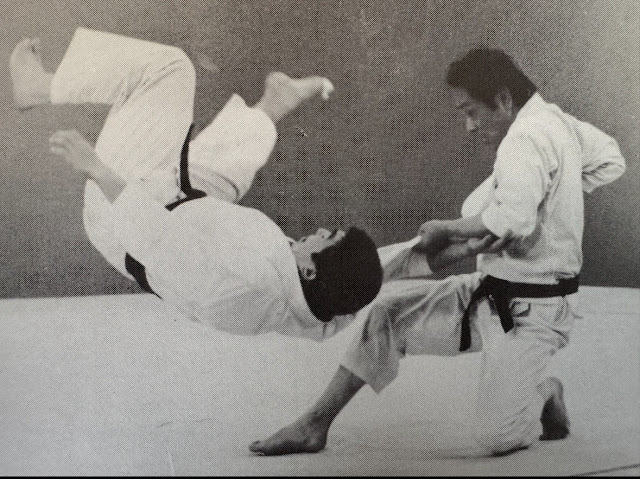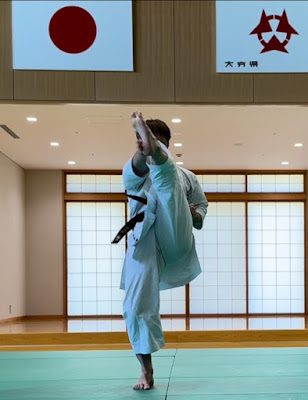This site is based on my daily practice of Shotokan Karate-Do here in Oita City, Japan. More than anything else, unlike the majority of other karate websites, this page is primarily dedicated to Budo Karate training itself; that is, Karate-Do as a vehicle for holistic development.
Wednesday, 28 May 2025
Today's Daily Keiko (and updates for 2026)
Friday, 23 May 2025
Szczecin, POLAND SEMINAR 2025 (Part Two): YOUTUBE VIDEO
The following YOUTUBE video has been comprised to give ‘little reminders’ of key aspects for those who attended the seminars. By watching this video, several of the fundamental budo/bujutsu principles—I taught over the two days—can be comprehensively reviewed by those who were there.
Tuesday, 20 May 2025
Szczecin, POLAND SEMINAR 2025 (Part One)
.JPG) |
| Attendees on the first day of the Szezezin, Poland 2025 Seminar. |
I just completed conducting my first Budo Karate Technical Seminar in Poland, which hosted by the UKS POMERANIA SZCZECIN karate club.
Here’s a link to their official website: https://karateklub.szczecin.pl and Facebook page: https://m.facebook.com/karatepomerania/
It was also super to catch up with several longtime friends.
I’d especially like to thank Paweł Karpow Sensei, chief instructor of Karate Pomerania; his wife Olga; and Arsenij Karpow Sensei. Furthermore, I’d like to thank all the members and supporters of UKS Pomerania Karate, and all those who attended the seminar.
My hope is that this seminar contributed to Karate by spreading traditional Shotokan knowledge directly from Japan; moreover, that each individual who attended can improve their skills from what was taught.
.JPG) |
| Members of the host UKS POMERANIA SZCZECIN karate club. |
André Bertel
7th Dan
International Karate Shotokan
国際空手道松濤館
Oita City, JAPAN
__________________________
Wednesday, 14 May 2025
"He probably has no equals" - (Nakayama Masatoshi Sensei)
 |
| Asai Sensei throwing Osaka Yoshiharu Sensei (Best Karate 3) |
"Tetsuhiko Asai's ever-changing movements, sometimes resembling a dance performed in the air, leave spectators gaping with admiration.
 |
Dodging under a kicking leg, striking to the groin from below, escaping an attack by a paper-thin margin, leaping for a sword hand attack to the opponent's neck, landing and reversing direction for a leg sweep-such intricate and acrobatic feats as these, which are of actual use in combat, he performs in kumite. He probably has no equals.
His inimitable talent has its source in training since youth, fostering powerful hips, a flexible body, deep technical skill, excellent reflexes and nerveless courage." - Nakayama Masatoshi.
© André Bertel. Oita City, Japan (2025).
Monday, 12 May 2025
A picture speaks a thousand words: Some recent images from my daily self-training here in Oita
Thursday, 8 May 2025
UPDATES
Greetings to all karateka here in Japan and around the world.
UPCOMING SEMINAR OUTSIDE JAPAN
This month I will be conducting the first Technical Seminar in Poland. For those attending, see you soon!
IKS Goals: UNCHANGED
The goal of International Karate Shotokan is a to preserve and spread the highest level of Traditional Budo Karate without political restrictions and outdated organizational structures.
We have deep respect and cooperation with other Shotokan groups, Goju Ryu, Wado Ryu, Shito Ryu and other styles. This is critical for mutual understanding and higher levels of technical karate development.
I encourage all karateka to seek knowledge from multiple sources. Seek to maximize your potential. Organizations means nothing without this. That is, don't rest on a brand label; rather, become the best you can be. This is TRUE BUDO/BUJUTSU.
RENSHUSEI
Besides the seminars here in Japan and abroad, the Renshusei Program here in Oita continues to produce excellence amongst Japanese and foreign karateka.
This is year has been fully booked up until October. For those wishing to book places, it is important to do so 'at least three months in advance'. In sum, book early to secure your days (and times) to avoid missing out.
To conclude, I want to thank everyone for their support. I am training each day seeking the skill levels of Asai Tetsuhiko Sensei, Nakamura Masamitsu Sensei, Osaka Yoshiharu Sensei, and other masters who have directly contributed to my technical evolution, and as an instructor of Karate-Do. I am also grateful for my wonderful students here in Japan and around the world. A deep bow to you all.
Friday, 2 May 2025
一、力の強弱体の伸縮技の緩急を忘るな
 |
| Maizuru-Dai Kata: Hidari teisho age-zuki, Migi ashi mae sanchin-dachi. |
 |
| Mae-geri keage with high reps... Sweating it out on the tatami, trying not to lose form: May 2nd, 2025. |
 |
| Movement 8 of Ransetsu: Hidari jodan mikizuki-geri, Usho-ate. |
KIHON
The focus of my kihon was KERIWAZA and to supplement this I used the 'basic training kata' 'RANSETSU', which is Asai Sensei's original version of the now more commonly practiced 'RANTAI'. Special attention was given to: (1) Mikazuki-geri; (2) Kansetsu-geri; (3) Mawashi-geri; (4) Ushiro-geri kekomi; (5) Yoko-geri kekomi; (6) Various forms of Fumikomi, including 'Kakato-otoshi.
Ashi soto-uke and Ashi uchi-uke were also practiced extensively.
While Nidan-geri is also in Ransetsu, I did not practice this in isolation.
The basic Mae-geri keage, 'the staple kick of Shotokan-Ryu' was also trained as usual as Sonoba-Kihon.
 |
| Maizuru-Dai Kata: Hidari ashi mae fudo-dachi, Hidari hitosashiyubi ippon-ken chudan-zuki. |
KATA
1. HANGETSU
2. JION
3. KAKUYOKU
4. MAIZURU DAI
 |
| The second to final action of the three Kakuyoku Kata. |
 |
| Movement 24 of Jion Kata: Hidari teisho, hidari sokumen chudan yoko-uke (Kiba-dachi) |
一、力の強弱体の伸縮技の緩急を忘るな
(Hitotsu, chikara no kyōjaku, karada no shinshuku, waza no kankyū o wasuruna)
"Do not forget the employment or withdrawal of power, the extension or contraction of the body, the swift or leisurely application of technique."
Thursday, 1 May 2025
Why is it imperative to develop one’s ‘OWN KARATE’?
 |
| Kanku Sho Kata. |
 |
| Sonkyo no mae-geri. |
 |
| Kakuyoku Nidan Kata |
 |
| Kakuyoku Sandan Kata. |
There are two obvious benefits of this more traditional “way”… Firstly, one maximizes their effectiveness and technical precision. Secondly, they do so in harmony with their physical attributes; thus, practices in a way which safely improves the body as opposed to harming it.
I’ll give you a concrete example. I had one Japanese black belt trainee who could do a perfect classical mawashi-geri in form. However, surprisingly, he told me it was painful for him. He asked me “what should I do?” I rhetorically asked him, “do you need this waza?”
 |
| Basic mae-geri keage practice. |
He said “Yes, an essential Shotokan waza”. I then said to him, “We both do Shotokan, but we are not Shotokan, only practitioners of it”. In sum, Shotokan is the vehicle, not the destination.
Of course, I’m 100% Shotokan, but this must be understood and trained accordingly if people want to maximize their individual potential.
If something is hindering you—‘in the vehicle’—and you’re long enough on your journey: reassess and, if needed, remove it.
This, of course, includes techniques which are damaging your body (like the aforementioned karateka with mawashi-geri).
I encourage senior grades to develop karate which maximizes their individual strengths and eradicates the weaknesses. This also protects their health; in particular, that of the musculoskeletal system.



















